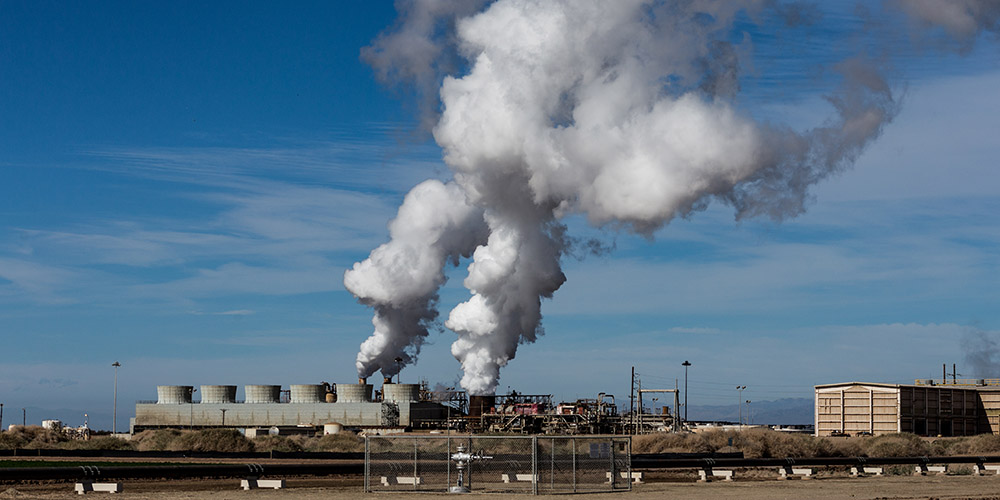
Geothermal plant near the Salton Sea (Photo: slworking/flickr)
California Forward is committed to advancing policy intersections that create a more inclusive and sustainable California where all people can prosper. The Voices of Shared Prosperity series amplifies the stories of Californians who are committing their time and talent to solutions that embrace equity, environmental sustainability, and economic opportunity.
California will need to rely on the sale of electric cars to meet its goal of banning gas-powered vehicles by 2035. To ensure there will be enough lithium — a key component in electric car batteries — Imperial County is transforming into Lithium Valley, an effort that could greatly increase the economic prospects of the region.
That’s the hope of Timothy Kelley, president and CEO of the Imperial Valley Economic Development Corporation and a third-generation resident of the region. His grandfather moved to the Imperial Valley in 1919 to operate a cantaloupe farm. More than 100 years later, Kelley is envisioning the region as a leader in clean, renewable energy.
“We pivoted from producing geothermal for energy to producing geothermal for the lithium industry, which is going to need energy,” said Kelley. “It’s a really symbiotic relationship between the two.” Geothermal power plants use heat from the earth to produce steam, which runs the turbines that produce electricity. The geothermal brine brought up from the power plants is enriched with minerals including lithium. There are currently 11 geothermal power stations along the Salton Sea with plans for more.
“This concept isn’t new to us,” said Kelley as geothermal plants have operated in the region for decades. “It’s just putting everything into place. The price needs to be there. The market needs to be there and the technology needs to be there. The third and the most important thing is the financing needs to be there.” He added, “Six months ago there was still doubt on the technology and six months ago there was still doubt on the financing. Now all those things are coming together.”
The increase in geothermal plants and lithium production will also bring greater economic opportunities to the region. It’s much needed as, according to CA FWD’s California Dream Index, Imperial County ranks below the state average in several categories, including residents living with income above the cost of living, attaining college degrees or completing career technical education, and residing in prosperous neighborhoods.
| Prosperous Neighborhoods: In 2019, percent of Imperial County residents living in census tracts with less than 20% in poverty fell to 36%, while statewide the percent has risen to 81%. Click here to learn about the Prosperous Neighborhoods indicator, one of ten included in our California Dream Index. |
|---|

Imperial County is a vibrant region and is one of the largest exporters of food, water and renewable energy in North America. “But the number one thing that we export out of this county is people,” said Kelley. “And the people are leaving for jobs and to go to college elsewhere.”
Kelley is working to increase the opportunity for higher education attainment, including at California State University at San Diego’s Calexico campus and Imperial Valley College. “All these entities are working together to make sure that we’re staying ahead of the game in training the local workforce for the future industries,” said Kelley.
As the renewable energy and lithium industries grow, the region will also need to grow. “How do we train and provide the workforce needed? How do we provide the housing that’s needed for the future that’s coming? It’s not that we’re giving up one industry for another. We’re adding to what we already do well – agriculture, logistics and others,” explained Kelley. “Definitely the excitement of lithium and geothermal is a great opportunity for our region.”
To make Lithium Valley a reality, Kelley says that certain things have to fall in place:
- Allow state permits for power plants over 50 megawatts, a restriction that Kelley says restriction doesn’t help with the economy of scale. There are about 15 geothermal plants in Imperial County at 49.9 megawatts.
- Fast-track federal and state funding
- Attract more domestic private investment
- Bring in other industries that will support geothermal energy and lithium production
Kelley said the Imperial County plants have to be up and running and in the market by 2025-26. “It seems like a long way out, but if you get these plans permitted, constructed, start producing batteries, they’re going to hit the market in the right time.” He added that in order to meet the predicted market demand for electric car batteries, there needs to be 10 to 30 regions doing what Imperial County is doing.
“Things are going to happen,” said Kelley. “We’ve got an opportunity to take an industry cluster and move it forward. We’re moving it forward in a way that says, rather than having it happen in our lifetime, let’s have it happen now.”

